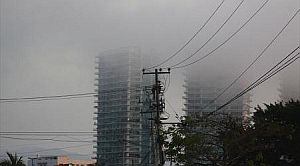Puerto Vallarta, Mexico - Over the last few days Puerto Vallarta has been overcast by a thin veil of haze, an atmospheric weather phenomenon that consists of very small particulars of suspended dust, ash or sand that people often confuse with fog or mist.
Commenting on recent statements made by the authorities and news media reporting the presence of 'an evening mist' in Vallarta, the head of the Centro Universitario de la Costa's Meteorology Bureau, Victor Manuel Cornejo Lopez, said "it is not fog or mist, it is haze."
Cornejo Lopez went on to say that this phenomenon occurs when water vapor traps salt particles from seawater, and in some cases smoke and ashes from a fire, which he considers to be the most feasible explanation in this case.
The scientist explained that in coastal areas there is a shifting wind called a 'marine-terral breeze' which means the wind currents alternate - during the day the wind originates from the ocean (commonly known as 'sea' or 'onshore' breezes,) and at night from inland ('land' or 'offshore' breezes.)
"When the wind shift is slight, these floating particles can diffuse some 50 miles both inland and out to sea, but when it is strong, they can travel as far as 200 kilometers."
Cornejo Lopez reported that satellite images indicate there are currently several fires burning in the western part of the country, some in the mountainous areas of this region, however they are not the cause of the haze because they did not occur near a big city, nor are they as large as the wildfire that's been burning at La Primavera Forest near Guadalajara since last Saturday.
"Large fires generate many more particles. The larger particles fall, but there are other very fine particles that keep floating. That's what we're seeing, haze caused by the fine particles that are trapped by moisture."
"These particles can be triggers for rain, but in this case there is not enough moisture in our area, he added. "We know that it's not fog because we are experiencing very low levels of relative humidity, or the atmosphere does not have enough moisture. Fog requires high humidity on one side and a cold dip on the other."
He asserted that this concentration of particles (haze) goes out to sea at night and comes back on the daytime sea breeze and runs along the coast before settles inland "It is dancing around," he quipped.
Cornejo Lopez explained that fog is whiter than haze, which at times can be dark, appearing milky, or somewhat blackened. "At certain times of the day, we can clearly see that milkiness over the mountains, which means that the particles are trapped by thermal inversion." (Thermal inversion occurs when a layer of warm air settles over a layer of cooler air that lies near the ground.)
Depending on its density, haze can cause decreased visibility and health issues such as respiratory problems, headaches, and soreness of the eyes, nose and throat.
Translated by Lorena Sonrisas for BanderasNews.com


